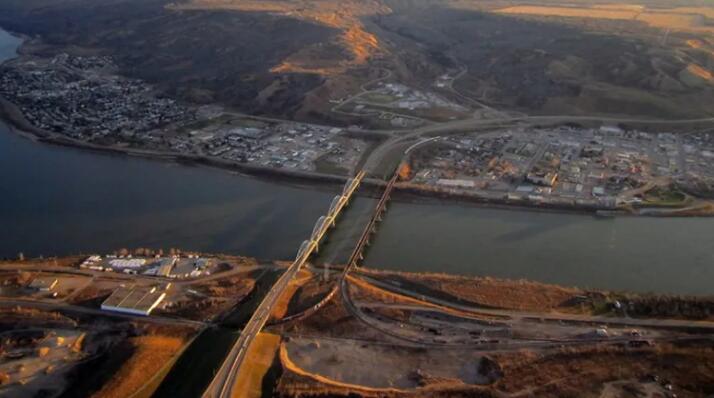Northern Alberta First Nation suing province over cumulative environmental effects

Duncan’s First Nation using arguments similar to those used successfully last year by B.C. group
A northern Alberta First Nation has filed what experts say is the province’s first lawsuit claiming cumulative effects from industry, agriculture and settlement are so pervasive, they violate the band’s treaty rights.
Duncan’s First Nation, southwest of Peace River, a town located about 500 kilometres north of Edmonton, alleges the province has permitted so much activity and sold off so much Crown land that band members can only live their constitutionally guaranteed way of life with great difficulty.
“Alberta has engaged in a pattern of conduct that has significantly diminished the (nation’s) right to hunt, fish and trap as part of their way of life,” says the statement of claim, filed in Edmonton in July.
“Habitats have been fragmented, lands and waters have been degraded, substances have been introduced that cause legitimate fears of contamination, and pollution and lands have been put to uses that are incompatible with the continued meaningful exercise of (the Nation’s) treaty rights.”
The province has not yet filed a statement of defence and the allegations have not been proven in court.
Alberta requires a cumulative effects assessment in environmental impact studies.
However, critics have long complained those assessments are cursory and given little weight. The band argues Alberta has continually permitted development and settlement on the band’s traditional lands project by project, without considering how all those activities add up.
Legal scholars have reached similar conclusions.
“These (cumulative) impacts cannot be resolved through piecemeal measures like individual permitting decisions,” reads a 2019 paper in the Alberta Law Review.
Jeff Langlois, a lawyer for the First Nation, said the band has taken part in every regulatory hearing that has affected them, to little effect.

“The cumulative impacts of all these projects have led to significant diminishment,” he said.
The band sent a letter to Premier Jason Kenney in May listing its concerns.
“We have repeatedly come up against Alberta’s appalling disregard for the challenges faced by our members in the exercise of their rights,” it says.
“Our people are now relegated to a small island.”
Duncan’s First Nation represents about 270 members.
Langlois said the premier did not respond and legal action is the only choice Duncan’s has left.
- How a big win for a First Nation in B.C. could bring change for resource development in Canada
- After landmark court victory, Treaty 8 Nations lay out vision for energy development in northeastern B.C.
“If they don’t sit down with us, we have to take another step.”
A provincial spokesperson declined to comment on the case.
Duncan’s First Nation is using arguments similar to those used successfully last year by the Blueberry First Nation in British Columbia, said Sean Sutherland, a Calgary lawyer with expertise in environmental and Indigenous law who recently wrote an analysis of the Alberta case.
“(The Blueberry decision) essentially directed changes to the regulatory regime that was in place in the area, which is quite an extraordinary remedy for a court to order,” he said.
“This claim is an attempt to bring the Blueberry First Nation type of analysis to Alberta.”
Langlois said Duncan’s saw Blueberry’s success and are trying to emulate it.
“They watched their cousins on the B.C. side of the border from Blueberry put their case forward and get findings from the court.”
As a result of that decision from B.C.’s Supreme Court, permit applications in the province’s northeast have been largely suspended since last summer. The court prohibited the province from authorizing more activities that breach treaty rights, imposing a six-month period for the parties to work out necessary changes.
That doesn’t make Duncan’s case a slam dunk, Sutherland said.
The facts on the ground must still be proved. As well, an Alberta court might rule differently on what constitutes loss of treaty rights.
“The standard that the British Columbia court relied on is that there’s infringement (on treaty rights) when there’s a significant or meaningful diminishment of rights on the basis of cumulative impacts,” said Sutherland.
“We don’t know if that same legal standard is going to apply in Alberta.”
- B.C. reaches $65M funding deal with First Nation after Supreme Court ruling
- B.C. says progress being made after court ruling on Blueberry River First Nation’s treaty rights
Sutherland said because of the complexity of the allegations, the B.C. case took years to work its way through the courts.
Duncan’s First Nation is seeking significant remedies. It wants legal, enforceable guarantees of consultation and research, as well as a permanent injunction blocking Alberta from permitting activities that damage the band’s ability to exercise its treaty rights.
While it may be the first band to take such arguments to court, it’s not the first to be concerned about the continual chipping away of traditional territory by permits for one development after another.
The Fort McKay Metis made such claims for years until the province agreed to protect a particularly valuable area.
Related News
Trump signs executive order to speed up deepsea mining permits
U.S. President Donald Trump on Thursday signed an executive order aimed at boosting the deepseaRead more
See the Ukraine war ceasefire proposals put forth by the Trump administration
Reuters has seen the text of a set of proposals to end Russia’s war inRead more
